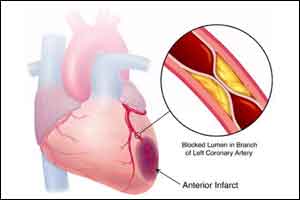- Home
- Editorial
- News
- Practice Guidelines
- Anesthesiology Guidelines
- Cancer Guidelines
- Cardiac Sciences Guidelines
- Critical Care Guidelines
- Dentistry Guidelines
- Dermatology Guidelines
- Diabetes and Endo Guidelines
- Diagnostics Guidelines
- ENT Guidelines
- Featured Practice Guidelines
- Gastroenterology Guidelines
- Geriatrics Guidelines
- Medicine Guidelines
- Nephrology Guidelines
- Neurosciences Guidelines
- Obs and Gynae Guidelines
- Ophthalmology Guidelines
- Orthopaedics Guidelines
- Paediatrics Guidelines
- Psychiatry Guidelines
- Pulmonology Guidelines
- Radiology Guidelines
- Surgery Guidelines
- Urology Guidelines
ESC issues new updated guidelines for acute STEMI

European Society of Cardiology (ESC) Guidelines on the management of acute myocardial infarction in patients with ST-segment elevation are published online today in European Heart Journal, and on the ESC website.
The document provides recommendations on topics not covered by the 2012 Guidelines and changes some previous recommendations following new evidence.
For the first time there is a clear definition of when to start the clock for the 90 minute target to treat patients with percutaneous coronary intervention (PCI). The clock should start at the time of ST-segment elevation myocardial infarction (STEMI) diagnosis by electrocardiogram (ECG).
“Until now there was confusion over whether the clock starts when the patient has the first symptoms, when he or she calls the emergency services, when the ambulance arrives on the scene, or when the patient arrives at the hospital,” said Task Force Chairperson Prof Stefan James (Sweden). “We don’t know if the patient is suffering from STEMI until the ECG so this is a sensible starting point and the vessel should be opened within 90 minutes from then.”
The vague term door-to-balloon has been removed from the guidelines and first medical contact (FMC) is defined as the time point when the patient is initially assessed by a physician, paramedic or nurse who obtains and interprets the ECG. “Door-to-balloon is no longer a useful term,” said Task Force Chairperson Dr Borja Ibanez (Spain). “Treatment used to be initiated in the hospital but now it can start in the ambulance so the ‘door’ varies according to the situation.”
In cases where fibrinolysis is the reperfusion strategy, the maximum time delay from the diagnosis of STEMI to treatment has been shortened from 30 minutes in 2012 to 10 minutes in 2017.
Complete revascularization was not recommended in the 2012 document which said that only infarct-related arteries should be treated. Today’s guidelines state that complete revascularization should be considered, with non-infarct-related arteries treated during the index procedure or another time point before discharge from hospital.
Thrombus aspiration is no longer recommended, based on two large trials in more than 15 000 patients. Also not recommended is deferred stenting, which involved opening the artery and waiting 48 hours to implant a stent. Regarding PCI, the use of drug eluting stents instead of bare metal stents has gained a stronger recommendation as has the use of radial, instead of femoral, arterial access.
When it comes to medications, the authors state that dual antiplatelet therapy extension beyond 12 months in selected patients may be considered. Bivalirudin has been downgraded from class I to IIa, and enoxaparin upgraded from class IIb to IIa. Cangrelor, which was not mentioned in the 2012 document, has been recommended as an option in certain patients. Also new is a recommendation for additional lipid lowering therapy in patients with high cholesterol despite taking the maximum dose of statins.
The cut off for administering oxygen therapy has been lowered from less than 95% to less than 90% arterial oxygen saturation. Left and right bundle branch block are now considered equal for recommending urgent angiography when patients have ischaemic symptoms.
A chapter has been added on myocardial infarction with non-obstructive coronary arteries (MINOCA), which comprises up to 14% of STEMI patients and demands additional diagnostic tests and tailored therapy which may differ from typical STEMI.
Prof James said: “The guidelines contain a whole set of new didactic figures and straightforward recommendations to help clinicians diagnosis and treat STEMI patients within a tight schedule.”
Dr Ibanez said: “We collaborated with other ESC Guideline Task Forces producing documents for this year and next, especially on dual antiplatelet therapy and the universal definition of myocardial infarction, to ensure consistency.”

Disclaimer: This site is primarily intended for healthcare professionals. Any content/information on this website does not replace the advice of medical and/or health professionals and should not be construed as medical/diagnostic advice/endorsement or prescription. Use of this site is subject to our terms of use, privacy policy, advertisement policy. © 2020 Minerva Medical Treatment Pvt Ltd